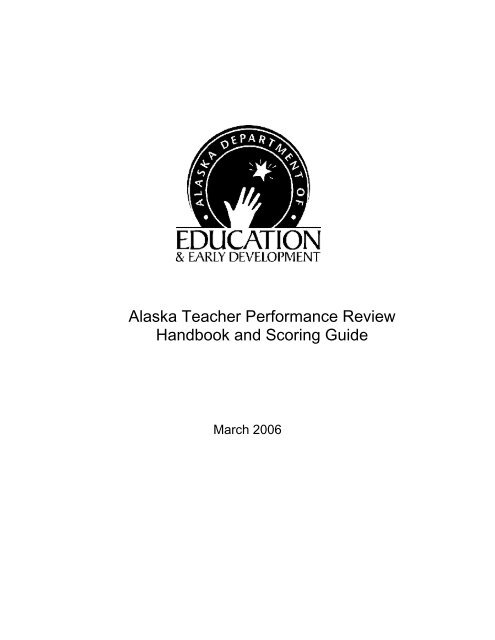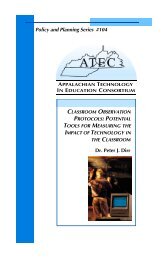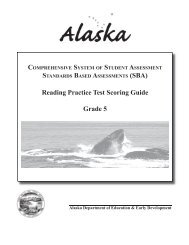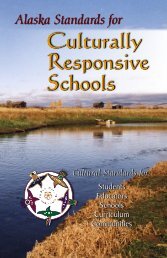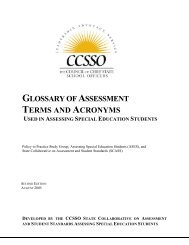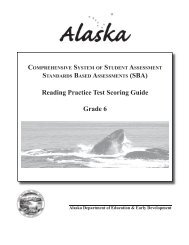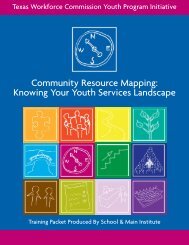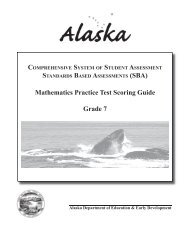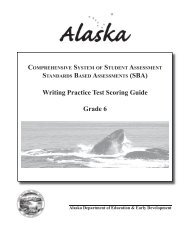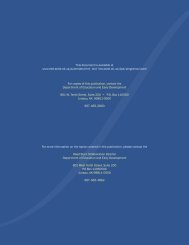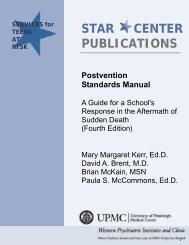Alaska Teacher Performance Review Handbook and Scoring Guide
Alaska Teacher Performance Review Handbook and Scoring Guide
Alaska Teacher Performance Review Handbook and Scoring Guide
You also want an ePaper? Increase the reach of your titles
YUMPU automatically turns print PDFs into web optimized ePapers that Google loves.
<strong>Alaska</strong> <strong>Teacher</strong> <strong>Performance</strong> <strong>Review</strong><strong>H<strong>and</strong>book</strong> <strong>and</strong> <strong>Scoring</strong> <strong>Guide</strong>March 2006
<strong>Alaska</strong> <strong>Teacher</strong> <strong>Performance</strong> <strong>Review</strong> <strong>H<strong>and</strong>book</strong> <strong>and</strong><strong>Scoring</strong> <strong>Guide</strong>Table of ContentsI. Overview <strong>and</strong> <strong>Guide</strong>lines 3-11• Overview <strong>and</strong> Purpose• General <strong>Guide</strong>lines• About the Videotapeo Videotape Requirementso Videotape Tipso Audio Quality Tips• Terms Used457-10771011II. Questions <strong>and</strong> Answers 15-23III. Sample Forms 25-32• Application Cover Sheet• ID page• Permission to Videotape• Sample Score Report• Request for Reconsideration2628293031IV. <strong>Scoring</strong> <strong>Guide</strong> 33-42V. Application <strong>and</strong> Checklist 43-54• Application Cover Sheet• ID page• Supporting Documentationo Part I General Classroom Informationo Part II Classroom Layouto Part III Information About InstructionSeen on the Videotape• <strong>Performance</strong> <strong>Review</strong> Checklist444647-5348505254VI. Appendix 55• Code of Ethics<strong>Alaska</strong> <strong>Teacher</strong> <strong>Performance</strong> <strong>Review</strong> <strong>H<strong>and</strong>book</strong> <strong>and</strong> <strong>Scoring</strong> <strong>Guide</strong> 2March 2006
Section I<strong>Alaska</strong> <strong>Teacher</strong> <strong>Performance</strong> <strong>Review</strong>Overview <strong>and</strong> <strong>Guide</strong>lines<strong>Alaska</strong> <strong>Teacher</strong> <strong>Performance</strong> <strong>Review</strong> <strong>H<strong>and</strong>book</strong> <strong>and</strong> <strong>Scoring</strong> <strong>Guide</strong> 3March 2006
OverviewIn September 2005, teacher certification in <strong>Alaska</strong> became a three-tiered,performance-based system consisting of Initial, Professional <strong>and</strong> Mastercertification. The new system requires teachers to demonstrate both their contentknowledge as well as their ability to deliver content knowledge to students. The<strong>Alaska</strong> <strong>Teacher</strong> <strong>Performance</strong> <strong>Review</strong> is one aspect of the teacher certificationprocess.The <strong>Alaska</strong> <strong>Teacher</strong> <strong>Performance</strong> <strong>Review</strong> is required of all teachers initiallycertified on September 1, 2006, or later, who seek Professional certification. The<strong>Alaska</strong> <strong>Teacher</strong> <strong>Performance</strong> <strong>Review</strong> consists of a 45-minute videotape <strong>and</strong> theSupporting Documentation for the videotape. <strong>Teacher</strong>s subject to theperformance review requirements in regulation must submit two performancereviews to <strong>Teacher</strong> Certification prior to the end of their second year of Initialcertification in <strong>Alaska</strong>.<strong>Teacher</strong>s may also use the performance review process for:• Moving to Master certification• Renewing Master certification• Earning highly qualified status for the purposes of No Child Left Behind• Earning Public RecognitionThe performance st<strong>and</strong>ards which form the foundation of the scoring guide arebased upon the St<strong>and</strong>ards for <strong>Alaska</strong>’s <strong>Teacher</strong>s <strong>and</strong> are the result of the work ofvarious committees <strong>and</strong> stakeholder groups within <strong>Alaska</strong>.The Supporting Documentation you provide sets the context for the videotapedlesson. It is important that you be clear <strong>and</strong> detailed when you provide theinformation for the Supporting Documentation. Scorers have been trained to lookfor evidence on the videotape that supports the contextual information providedin the Supporting Documentation.The <strong>Alaska</strong> <strong>Teacher</strong> <strong>Performance</strong> <strong>Review</strong> is scored by trained reviewers who areclassroom teachers in <strong>Alaska</strong>. The reviewers represent all geographic areas ofthe state including rural <strong>and</strong> urban communities. The reviewers also represent awide variety of endorsement areas as well as grade levels.<strong>Alaska</strong> <strong>Teacher</strong> <strong>Performance</strong> <strong>Review</strong> <strong>H<strong>and</strong>book</strong> <strong>and</strong> <strong>Scoring</strong> <strong>Guide</strong> 4March 2006
General <strong>Guide</strong>lines• Before beginning the performance review, read through the <strong>Alaska</strong><strong>Teacher</strong> <strong>Performance</strong> <strong>Review</strong> <strong>H<strong>and</strong>book</strong> <strong>and</strong> <strong>Scoring</strong> <strong>Guide</strong> to becomefamiliar with the requirements <strong>and</strong> scoring of the performance review.• Provide all the requested information. Failure to do so will result in theperformance review materials being returned without being scored.• If you submit videotapes <strong>and</strong> Supporting Documentation for the purpose ofbecoming highly qualified under the HOUSSE (high, objective, uniform,state st<strong>and</strong>ard of evaluation), or receiving public recognition, the cost is$25 per submission.• The <strong>Scoring</strong> <strong>Guide</strong> provides the performance st<strong>and</strong>ards, levels ofperformance, <strong>and</strong> indicators of performance. It will be helpful to reviewthese before <strong>and</strong> after making the videotape.• The Supporting Documentation will provide the reviewers with informationthat may not be readily seen on the videotape but is necessary tounderst<strong>and</strong> the instruction on the videotape. Be clear <strong>and</strong> detailed whencompleting the Supporting Documentation.• If you choose not to complete the Supporting Documentation using a wordprocessing program, write legibly <strong>and</strong> use ink when completing theSupporting Documentation <strong>and</strong> the classroom map.• The Supporting Documentation is used during the scoring process. Youmay wish to review your videotape to compare what is on the tape withyour responses to the items in the Supporting Documentation. Make surethe provided information supports the instruction seen on the videotape.• It is important for you to clearly communicate your practice to thereviewers. Grammar mistakes <strong>and</strong> spelling errors detract from writtencommunication. Proofread your Supporting Documentation to make surethe information you provided is clearly conveyed.• Be sure to define any acronyms or abbreviations used when providing therequested information in the Supporting Documentation, e.g. DOL (DailyOral Language).<strong>Alaska</strong> <strong>Teacher</strong> <strong>Performance</strong> <strong>Review</strong> <strong>H<strong>and</strong>book</strong> <strong>and</strong> <strong>Scoring</strong> <strong>Guide</strong> 5March 2006
• Prior to making your videotape, you may want to find out if there is a firedrill or other school wide process planned during the instruction.Interruptions may make it difficult to complete the videotaping within thetime requirements.• You may want to consider putting a sign, such as “Taping- Do Not Disturb”on your classroom door to let others know when you are in the process ofmaking your videotape.• You should make a copy of your performance review (SupportingDocumentation <strong>and</strong> videotape) for your records. Although the videotapewill be returned to you after 90 days, the Supporting Documentation willbecome a part of your permanent file in <strong>Teacher</strong> Certification <strong>and</strong> will notbe returned.• It is strongly suggested that you view the copy of your videotape to makesure it has copied.• When mailing your <strong>Performance</strong> <strong>Review</strong>, it is strongly suggested youpackage the video <strong>and</strong> Supporting Documentation in a sturdy container.Using a tracking slip will provide you confirmation of delivery. Damagedvideotapes will not be scored <strong>and</strong> will be returned to you.<strong>Alaska</strong> <strong>Teacher</strong> <strong>Performance</strong> <strong>Review</strong> <strong>H<strong>and</strong>book</strong> <strong>and</strong> <strong>Scoring</strong> <strong>Guide</strong> 6March 2006
About the VideotapeVideotape Requirements:• Your videotape must show 45 minutes of instruction in your teachingassignment.• If the instruction shown on the videotape exceeds 45 minutes, only thefirst 45 minutes of instruction will be scored.• Videotapes less than 45 minutes long will be returned to you without beingscored.• The videotape must be clearly labeled with your name.• The videotape must roll continuously once the recording starts. Any stopsduring the recording that result in a break or interruption of the recording,will result in your video being returned to you without being scored.• The videotape may not be edited in any way. This includes audiodeletions, subtitles, freeze-frames, or other special effects.• The audio <strong>and</strong> video recordings must be clear so the reviewers are able toclearly view <strong>and</strong> hear your instruction as well as students’ responses.• The submitted videotape must not be damaged or broken.• Make sure the completed videotape is completely rewound before it issubmitted.Videotape Tips:The following guidelines are provided to help you prepare the videotape of yourclassroom instruction for your performance review. It is the quality of the lessonpresented, not the quality of the video that is most important. However, a qualityvideo will easily allow reviewers to see your instruction.You may want to practice videotaping prior to recording your instruction for theperformance review. This will help both you <strong>and</strong> your students to becomefamiliar with the video camera.You may either do the videotaping yourself or ask someone to do it for you.When you have someone do the videotaping for you, be sure to allow the persontime to become familiar with the equipment he or she will be using.<strong>Alaska</strong> <strong>Teacher</strong> <strong>Performance</strong> <strong>Review</strong> <strong>H<strong>and</strong>book</strong> <strong>and</strong> <strong>Scoring</strong> <strong>Guide</strong> 7March 2006
• <strong>Review</strong> your video in its entirety to check its quality. If the sound <strong>and</strong>visual quality are not good, you may wish to videotape another lesson.• When finished recording, the record-enabling tab on the spine of thevideocassette should be removed in order to prevent the accidental tapingover of your lesson.Following are examples of camera set-ups. You may want to experiment withcamera placement in your classroom in order to achieve the best results for yourparticular situation.Coats<strong>Teacher</strong>DeskChalkboard BooksStudentGroup 1StudentGroup 3<strong>Teacher</strong>StudentGroup 2StudentGroup 4Small GroupInstructionTableWindowsCameraCentersDoorCenter MaterialsFront<strong>Teacher</strong>StudentGroupStudentGroupCameraStudentGroupWindowsStudentGroupStudentGroupRear<strong>Alaska</strong> <strong>Teacher</strong> <strong>Performance</strong> <strong>Review</strong> <strong>H<strong>and</strong>book</strong> <strong>and</strong> <strong>Scoring</strong> <strong>Guide</strong> 9March 2006
Front<strong>Teacher</strong>CameraRearAudio Quality Tips:• Always keep the microphone toward what is happening in the classroom.Consider carrying an external microphone, if you are moving around yourclassroom during your instruction.• Use an external PZM ® microphone to enhance sound quality.• Eliminate noises that might interfere with taping such as fans. Try not tocompete with outside noises such as recess or b<strong>and</strong> practice.• If you have a camera operator, have the person wear headphones so thatas problems with the audio occur, they can be fixed.• Be sure that all cables are secured <strong>and</strong> if necessary use masking tape tokeep them in place. Many audio problems are the result of faultyconnections, not poor equipment quality.<strong>Alaska</strong> <strong>Teacher</strong> <strong>Performance</strong> <strong>Review</strong> <strong>H<strong>and</strong>book</strong> <strong>and</strong> <strong>Scoring</strong> <strong>Guide</strong> 10March 2006
Terms used in the <strong>Alaska</strong> <strong>Teacher</strong> <strong>Performance</strong><strong>Review</strong> <strong>and</strong> <strong>Scoring</strong> <strong>Guide</strong>alignmentThe effort to ensure that what teachers teach is in accord with what thecurriculum says will be taught <strong>and</strong> what is assessed on official tests.assessmentAssessment is measuring the learning <strong>and</strong> performance of students orteachers. Different types of assessment instruments include achievementtests, minimum competency tests, developmental screening tests, aptitudetests, observation instruments, performance tasks, <strong>and</strong> authenticassessments.• Formative assessment occurs while the topic is being taught, providesdiagnostic information on specific mistakes <strong>and</strong> misconceptions, <strong>and</strong>leads to instructional adaptations• Summative assessment is the process of evaluating (<strong>and</strong> grading) thelearning of students at a point in time. Accountability decisions arederived from summative assessment data.building resourcesIncludes other educators as well as teaching materials that are sharedbetween classrooms.classroom climateThe "feel" or tone of a classroom, indicated by the total environment,including especially the way teacher <strong>and</strong> students relate to one another.classroom managementThe way a teacher organizes <strong>and</strong> administers routines to make classroomlife as productive <strong>and</strong> satisfying as possible.classroom routinesClassroom routines are non-instructional, organizational, administrative orrepetitive activities such as roll-taking, pencil-sharpening, or thedistribution of materials <strong>and</strong> equipment. The distribution of materials <strong>and</strong>equipment may be to prepare for instruction.collaborationCollaboration is a relationship between individuals or organizations thatenables the participants to accomplish goals more successfully than theycould have separately.<strong>Alaska</strong> <strong>Teacher</strong> <strong>Performance</strong> <strong>Review</strong> <strong>H<strong>and</strong>book</strong> <strong>and</strong> <strong>Scoring</strong> <strong>Guide</strong> 11March 2006
content st<strong>and</strong>ardsContent st<strong>and</strong>ards are broad statements of what students should know<strong>and</strong> be able to do as a result of their public school experience.cooperative learningA teaching strategy combining teamwork with individual <strong>and</strong> groupaccountability. Working in small groups, with individuals of varying talents,abilities, <strong>and</strong> backgrounds, students are given one or more tasks. Theteacher or the group often assigns each team member a personalresponsibility that is essential to successful completion of the task.curriculumAlthough this term has many possible meanings, it usually refers to awritten plan outlining what students will be taught (a course of study).Curriculum documents often also include detailed directions orsuggestions for teaching the content. Curriculum may refer to all thecourses offered at a given school, or all the courses offered at a school ina particular area of study. For example, the English curriculum mightinclude English literature, literature, world literature, essay styles, creativewriting, business writing, Shakespeare, modern poetry, <strong>and</strong> the novel. Thecurriculum of an elementary school usually includes language arts,mathematics, science, social studies, <strong>and</strong> other subjects.differentiated instructionIn differentiated instruction several different learning experiences areoffered in response to students' varied needs. Learning activities <strong>and</strong>materials may be varied by difficulty to challenge students at differentreadiness levels, by topic in response to students' interests, <strong>and</strong> bystudents' preferred ways of learning or expressing themselves. Indifferentiated instruction individual student assessment data is used toplan instruction.direct instructionInstruction in which the teacher explains the intended purpose <strong>and</strong>presents the content in a clear, orderly way. Contrasts with inductive,discovery, or constructive teaching, in which students are led, by means ofinvestigation or discussion, to develop their own ideas.diversityIn education, discussions about diversity involve recognizing a variety ofstudent needs including those of ethnicity, language, socioeconomic class,disabilities, <strong>and</strong> gender.<strong>Alaska</strong> <strong>Teacher</strong> <strong>Performance</strong> <strong>Review</strong> <strong>H<strong>and</strong>book</strong> <strong>and</strong> <strong>Scoring</strong> <strong>Guide</strong> 12March 2006
environment for learningThe environment for learning takes into consideration both the physical<strong>and</strong> social aspects of the classroom. It is the setting where learning takesplace. <strong>Teacher</strong>s create an environment of respect <strong>and</strong> rapport while theyestablish a culture for learning. <strong>Teacher</strong>s manage classroom procedures<strong>and</strong> student behavior within the environment for learning.grade level expectations (GLEs)Are statements that define what all students should know <strong>and</strong> be able todo at the end of a given grade level. They are meant to further define acontent st<strong>and</strong>ard.implementation of instructionIn the implementation of instruction teachers engage students in learningthrough their use of questioning <strong>and</strong> discussion techniques. <strong>Teacher</strong>sprovide students with feedback on their learning.inclusionThe practice of educating all children in the same classroom, includingchildren with physical, mental, <strong>and</strong> developmental disabilities.indicatorsAs used in the <strong>Alaska</strong> <strong>Teacher</strong> <strong>Performance</strong> <strong>Review</strong>, indicators giveteachers <strong>and</strong> reviewers an idea of what might be evident in a teacher’spractice at a given performance level.instructional strategiesThe following list is not all inclusive. It is intended to give teachers <strong>and</strong>reviewers an idea of the instructional strategies that may be seen on thevideotapes:K-W-L chart guided practice scaffoldingquestioning drill <strong>and</strong> practice memorizationliterature circles learning centers think, pair, sharejournals guided reading direct instructionthink aloud role playing lecturecooperative learning brainstorming discussioninquiry use of manipulatives modelingactivate prior knowledge problem solving computer-assistedinstructionchoral response games simulationscenters project-based learning demonstrationsinterdisciplinaryA way of organizing the curriculum in which content is drawn from two ormore subject areas to focus on a particular topic or theme.<strong>Alaska</strong> <strong>Teacher</strong> <strong>Performance</strong> <strong>Review</strong> <strong>H<strong>and</strong>book</strong> <strong>and</strong> <strong>Scoring</strong> <strong>Guide</strong> 13March 2006
performance st<strong>and</strong>ards<strong>Performance</strong> st<strong>and</strong>ards provide a road map for the development ofassessment items for <strong>Alaska</strong>’s St<strong>and</strong>ard-Based Assessment. In <strong>Alaska</strong>the performance st<strong>and</strong>ards are measured annually at the end of grades 3through 10.planning <strong>and</strong> preparationIn planning <strong>and</strong> preparation for instruction teachers demonstrate theircontent knowledge, their knowledge of students <strong>and</strong> knowledge ofinstructional resources. They demonstrate their ability to selectinstructional goals <strong>and</strong> design instruction to meet those goals. They plantheir assessment of student learning as well as how to use the results ofassessments.scaffoldingStudents are given support until they can apply new skills <strong>and</strong> strategiesindependently. When students are learning new or difficult tasks they aregiven more assistance. As students begin to demonstrate mastery, theassistance or support is decreased gradually.technologyThe term technology has a variety of applications from pencil to computer.The following list is not all inclusive. Its purpose is to give teachers <strong>and</strong>reviewers an idea of what technology might be in use in a classroom:calculator computer CD-ROMvideo/DVD player camera overhead projectorLCD projector Smart board White boardtape recorderinstructional software personal fm unitsprogramscommunication boards speech synthesizers phonic phoneswhisper phonestools of inquiryEach content area has tools of inquiry used to help students explore thenatural or material world <strong>and</strong> lead to asking questions <strong>and</strong> makingdiscoveries in the search for new underst<strong>and</strong>ings.transitionsTransitions are non-instructional organizational or administrative movesfrom one classroom activity or context to another. They may occurbetween instructional <strong>and</strong> non-instructional activities.<strong>Alaska</strong> <strong>Teacher</strong> <strong>Performance</strong> <strong>Review</strong> <strong>H<strong>and</strong>book</strong> <strong>and</strong> <strong>Scoring</strong> <strong>Guide</strong> 14March 2006
Section II<strong>Alaska</strong> <strong>Teacher</strong> <strong>Performance</strong> <strong>Review</strong>Questions <strong>and</strong> Answers<strong>Alaska</strong> <strong>Teacher</strong> <strong>Performance</strong> <strong>Review</strong> <strong>H<strong>and</strong>book</strong> <strong>and</strong> <strong>Scoring</strong> <strong>Guide</strong> 15March 2006
TimelinesI am a classroom teacher. What are my timelines for completing theperformance review?You must submit two performance reviews prior to the end of your secondyear of Initial certification.Should you not meet the performance review requirement by the end ofyour second year of Initial certification, you may submit additionalperformance reviews as necessary to meet the requirement. There is nolimit on the number of performance reviews you can submit.When is my first performance review due?While there is no requirement for submission of the first performancereview, it is strongly recommended that you plan to submit your firstperformance review prior to the end of your first year of Initial certification.I have Initial certification but I am not a classroom teacher. What are mytimelines for completing the performance review?If you are in a non-instructional position, you may move to Professionalcertification without completing the performance review. When you applyfor Professional certification, you must provide <strong>Teacher</strong> Certificationverification that you hold a non-instructional position.In order to maintain your Professional certification when you obtain aninstructional position, you will need to meet the performance reviewrequirements within two years of obtaining the instructional position.What happens if I can’t complete the performance review within therequired time?A teacher who does not meet the performance review requirement tomove to Professional certification prior to the expiration date on his or herInitial certificate may be eligible, under certain circumstances to reapplyfor Initial certification. The teacher must contact <strong>Teacher</strong> Certification toverify his or her eligibility prior to making another application for Initialcertification.CostHow much does the performance review cost?<strong>Teacher</strong>s holding Initial certification may submit up to three performancereviews for the purpose of moving to Professional certification withoutpaying a fee. Each succeeding submission costs $25.<strong>Alaska</strong> <strong>Teacher</strong> <strong>Performance</strong> <strong>Review</strong> <strong>H<strong>and</strong>book</strong> <strong>and</strong> <strong>Scoring</strong> <strong>Guide</strong> 16March 2006
Should I use the performance st<strong>and</strong>ards, levels of performance <strong>and</strong>indicators when planning my lesson?Yes. The performance st<strong>and</strong>ards are what a teacher is supposed to know<strong>and</strong> be able to do. The levels of performance denote what a teacher’spractice would look like for the st<strong>and</strong>ard at a given level. Level 2 isconsidered proficient. The indicators indicate what might be in evidence ina lesson at a given performance level. It is important to note the indicatorsare not used as a checklist in scoring.Is the Supporting Documentation important?Yes. The Supporting Documentation is very important in the preparationas well as scoring of the performance review. The SupportingDocumentation provides evidence for performance reviewers in areas thatare not readily seen on a videotape. The reviewers will use informationprovided in the Supporting Documentation when scoring performancereviews.What do I do when I teach primary students <strong>and</strong> 45 minutes is too long forone lesson?In a 45 minute period a primary teacher may be doing more than onelesson <strong>and</strong> have transitions between lessons. It is the teacher’sresponsibility to clearly explain in the Supporting Documentation allinstruction <strong>and</strong> transitions seen on the videotape.How can I complete the review, when my class periods are not 45 minuteslong?You can work with the teachers in your building that would be impacted byyour needing more time with students to work out a schedule that willallow you the time needed to complete a videotape for the performancereview.What happens if I don’t pass the performance review?You have several opportunities to pass the performance review duringyour Initial certification period (three years).If a teacher does not pass the performance review during the Initialcertification period <strong>and</strong> is not eligible for Professional certification, theteacher may be eligible to reapply for Initial certification. <strong>Teacher</strong>s in thissituation must contact <strong>Teacher</strong> Certification to determine their eligibility.See also the section on Reconsideration <strong>and</strong> Appeals.How many times can I do the performance review?You may submit as many videotapes <strong>and</strong> Supporting Documentation asyou need to pass the performance review.<strong>Alaska</strong> <strong>Teacher</strong> <strong>Performance</strong> <strong>Review</strong> <strong>H<strong>and</strong>book</strong> <strong>and</strong> <strong>Scoring</strong> <strong>Guide</strong> 18March 2006
Should I keep a copy of my performance review?It is strongly suggested you keep a copy of your SupportingDocumentation <strong>and</strong> videotape in the event your tape is lost in the mail orreceived damaged or broken.<strong>Scoring</strong>Who will score my performance review?<strong>Performance</strong> reviews will be scored by classroom teachers who havebeen trained to do the scoring. Whenever possible, performance reviewsthat cover specific content areas will be reviewed by teachers with abackground in the content area.What makes a performance review unscorable?A performance review will not be scored when:• the Supporting Documentation is not complete• the Supporting Documentation is illegible• applicable fees are not included• a copy of a photo id is not included• the application is not signed by the applicant <strong>and</strong>/or lacks averification signature• there is poor audio quality at any point in the videotape that resultsin reviewers not being able to hear the instruction on the videotape• there is poor video quality at any point in the videotape thatimpedes viewing the videotape• the teacher <strong>and</strong>/or students are not visible or audible on thevideotape• the videotape shows less than 45 minutes of instruction• there is evidence of editing• there are stops during the recording that result in a break orinterruption of the recording• the videotape is not submitted in the specified format• the videotape is received damaged or brokenUnscorable performance reviews will be returned to the applicant.How will my performance review be scored?• Each performance review will be scored independently by twoperformance reviewers.• Prior to viewing a teacher’s videotape, the reviewer reads theteacher’s Supporting Documentation <strong>and</strong> documents evidence ofthe performance st<strong>and</strong>ards from the Supporting Documentation.• The reviewer then views the videotape in its entirety to collectevidence that supports the st<strong>and</strong>ards being met.<strong>Alaska</strong> <strong>Teacher</strong> <strong>Performance</strong> <strong>Review</strong> <strong>H<strong>and</strong>book</strong> <strong>and</strong> <strong>Scoring</strong> <strong>Guide</strong> 19March 2006
• After viewing the videotaped lesson through once, a reviewer maychoose to return to the tape to gather more evidence of thest<strong>and</strong>ards.• Prior to making a final scoring decision, the reviewer will compareevidence gathered from the videotaped lesson with what theteacher has reported in his or her Supporting Documentation.• If there is not congruence between the Supporting Documentation<strong>and</strong> the videotaped lesson the st<strong>and</strong>ards will not have been met ata proficient level.• Once the reviewer has completed the scoring process, theevidence <strong>and</strong> scores are recorded <strong>and</strong> turned into <strong>Teacher</strong>Certification.What happens when the reviewers don’t agree on the scores?When there is not agreement between performance reviewers, theperformance review will be assigned to a third reviewer to conduct aperformance review.As with all performance reviews, reviewers will not have knowledge ofwhether or not a performance review has been conducted prior to his orher review.What happens to my performance review after it has been scored?The Supporting Documentation will be scanned into teachers’ files in<strong>Teacher</strong> Certification. Videotapes will be kept in <strong>Teacher</strong> Certification for90 days after the performance review. After the 90 days the videotape willbe returned to the applicant. The Supporting Documentation will become apart of a teacher’s permanent file <strong>and</strong> will not be returned.What happens if I don’t agree with my score on the performance review?If the score on the performance review would result in the denial ofcertification, you may request reconsideration. If you think your scoreshould have been higher but the score you received does not have theresult of denying you certification, you may not request reconsideration.What happens if I am denied certification as a result of my performancereview?Under certification regulations, a teacher who is denied certification as aresult of the performance review may request reconsideration from thedepartment. A request for reconsideration must be filed in writing within 15days after the teacher receives notice that he or she has not successfullycompleted the review. The request must set out in detail the reasons whythe teacher believes the review was in error.<strong>Alaska</strong> <strong>Teacher</strong> <strong>Performance</strong> <strong>Review</strong> <strong>H<strong>and</strong>book</strong> <strong>and</strong> <strong>Scoring</strong> <strong>Guide</strong> 20March 2006
Should there be administrative proceedings regarding a performancereview, the videotape will be returned to the applicant following thetermination of those proceedings.Miscellaneous QuestionsWhat do I do when a parent won’t let his or her child be seen on thevideotaped lesson?You may want to consider:• including the student in the lesson while seating the student out ofcamera range during the videotaping• asking a colleague to allow the student to work independently in hisor her classroomWhat’s the best way to mail the videotape <strong>and</strong> Supporting Documentation?There are mailers available for videotapes at many post offices. If this isnot an option at your local post office, you may want to consider mailingthe tape in an insulated mailing envelope.How will I know if my performance review materials got to <strong>Teacher</strong>Certification?Using a delivery confirmation label will allow you to track the performancereview materials <strong>and</strong> know the date of delivery to the state. <strong>Teacher</strong>Certification usually receives mail the day after it has been delivered to thestate’s central mail office.How soon will I know my score on the performance review?Applicants should receive official scores on the performance review within4-6 weeks after the performance review is received by <strong>Teacher</strong>Certification.Can I submit more than one performance review at a time?Yes. Each review will be conducted independently. <strong>Teacher</strong>s submittingmore than one performance review at a time must clearly label theperformance review materials. Each performance review must have itsown cover sheet <strong>and</strong> Supporting Documentation <strong>and</strong> must indicate whichmaterials belong together.What if I am not working in a teaching position during my Initialcertification period?<strong>Teacher</strong>s not working in a teaching position during their Initial certificationperiod do not have to complete the performance review in order to moveto Professional certification. However, they must complete all othercertification requirements within the Initial certification period.<strong>Alaska</strong> <strong>Teacher</strong> <strong>Performance</strong> <strong>Review</strong> <strong>H<strong>and</strong>book</strong> <strong>and</strong> <strong>Scoring</strong> <strong>Guide</strong> 21March 2006
<strong>Teacher</strong>s working in a school district in a position other than that of aclassroom teacher will need to submit a letter from the school district thatverifies their position in the district or a copy of his or her current contractwith the school district as part of the completed application.<strong>Teacher</strong>s, who are not working in a school district, may submit a letterattesting to the fact they are not teaching as part of their completedapplication.How many performance reviews must I successfully complete to earn thepoints for the HOUSSE? Are there additional fees?In order to receive the 100 points for the HOUSSE, a teacher must obtaina total score of 16 on each of two performance reviews, with no individualscore on a st<strong>and</strong>ard below 2, the proficient level. There are no pointsawarded until the second performance review has been passed at theproficient level. <strong>Teacher</strong>s wishing to use the performance review to build aHOUSSE must include a $25 fee with each submission.How many performance reviews must I complete to obtain Mastercertification or to renew my Master certification? Are there additional fees?In order to earn Master certification a teacher must obtain a total score of24 on each of two performance reviews with no individual score below a 3.There are no additional fees to move from Initial certification to Mastercertification.<strong>Teacher</strong>s holding Professional certification, who wish to obtain Mastercertification, or renew Master certification, are not required to submit a fee.How can I use the performance review to move from Initial certification toMaster certification? Are there any additional fees for this?It is possible for a teacher to move from Initial certification to Mastercertification if the required scores are met. There are no additional fees forthis.Who will see my performance review?Only trained performance reviewers will view the videotapes.Reconsideration <strong>and</strong> AppealsHow will I know that I didn’t pass the performance review?You will be notified by both email <strong>and</strong> regular mail. You must keep currentemail <strong>and</strong> regular mail addresses on file in teacher certification:tcertwebmail@eed.state.ak.us.<strong>Alaska</strong> <strong>Teacher</strong> <strong>Performance</strong> <strong>Review</strong> <strong>H<strong>and</strong>book</strong> <strong>and</strong> <strong>Scoring</strong> <strong>Guide</strong> 22March 2006
When can I request reconsideration?You can request reconsideration if you have already passed oneperformance review.When you receive notification that you did not pass the performancereview you may request reconsideration.Your request for reconsideration must be received in <strong>Teacher</strong> Certificationwithin 15 days after you have received notice that you have notsuccessfully completed a performance review.How do I request reconsideration?You need to use the Request for Reconsideration Form. You must set outin detail why you believe the determination of your performance reviewwas in error.What is the timeline for requesting reconsideration?Your request for reconsideration must be received in <strong>Teacher</strong> Certificationwithin 15 days after you have received notice that you have notsuccessfully completed a performance review.What happens if my not passing the performance review makes meineligible to obtain Master certification?You may request a reconsideration if you have already passed oneperformance review <strong>and</strong> achieved the score necessary for Mastercertification.When can I appeal the performance review?You may request an appeal when the results of a performance reviewresult in your being denied Professional or Master certification.In order to request an appeal you must have already met all other criteriafor the certification you seek.Please contact <strong>Teacher</strong> Certification for the requirements for your specificcertificate.What is the appeals process?The appeals process is through the Professional Teaching PracticesCommission. Please contact the PTPC for information on the appealsprocess.<strong>Alaska</strong> <strong>Teacher</strong> <strong>Performance</strong> <strong>Review</strong> <strong>H<strong>and</strong>book</strong> <strong>and</strong> <strong>Scoring</strong> <strong>Guide</strong> 23March 2006
<strong>Alaska</strong> <strong>Teacher</strong> <strong>Performance</strong> <strong>Review</strong> <strong>H<strong>and</strong>book</strong> <strong>and</strong> <strong>Scoring</strong> <strong>Guide</strong> 24March 2006
Section III<strong>Alaska</strong> <strong>Teacher</strong> <strong>Performance</strong> <strong>Review</strong>Sample Forms<strong>Alaska</strong> <strong>Teacher</strong> <strong>Performance</strong> <strong>Review</strong> <strong>H<strong>and</strong>book</strong> <strong>and</strong> <strong>Scoring</strong> <strong>Guide</strong> 25March 2006
<strong>Alaska</strong> <strong>Teacher</strong> <strong>Performance</strong> <strong>Review</strong>Application Cover SheetNameAddressSSN#City State Zip CodeEmail (required)School DistrictSchoolPurpose for which video is being submitted (Check all that apply):Initial to Professional or Master certificationPublic RecognitionProfessional to Master certificationRenewal of Master certificationHOUSSE (High Objective Uniform State St<strong>and</strong>ard of Evaluation)Number of performance reviews previously submittedFee Schedule: Unless noted, all fees for performance reviews are $25 per submission.Initial to Professional or Master certification (No fee)Initial to Professional or Master certification (4 th submission <strong>and</strong> beyond)Public RecognitionProfessional to Master certification (No fee)Renewal of Master certification (No fee)HOUSSE (High Objective Uniform State St<strong>and</strong>ard of Evaluation)YOU MAY PAY WITH A CHECK (PAYABLE TO EED), MONEY ORDER, OR CREDIT CARD.FEES ARE NON-REFUNDABLE. DEBIT CARDS OF ANY KIND WILL NOT BE ACCEPTED.TYPE OF PAYMENT VISA MASTERCARDCHECK # MONEY ORDER #0 0 0 . 0 0AMOUNTCREDIT CARD NUMBEREXPIRATION DATE (MM/YY)/NAME ON CREDIT CARDCARDHOLDER’S SIGNATURE<strong>Alaska</strong> <strong>Teacher</strong> <strong>Performance</strong> <strong>Review</strong> <strong>H<strong>and</strong>book</strong> <strong>and</strong> <strong>Scoring</strong> <strong>Guide</strong> 26March 2006
Please complete <strong>and</strong> submit this form with the videotape for review. Submit all materials to:<strong>Teacher</strong> Certification<strong>Alaska</strong> Department of Education & Early Development801 West 10 th Street, Suite 200P.O. Box 110500Juneau, <strong>Alaska</strong> 99811-0500All videotapes submitted are confidential <strong>and</strong> will be returned to the sender after the expiration of 90 days from thecompletion of the performance review, or the termination of administrative or court proceedings related to a review under4 AAC 12.320, whichever is later.You must keep a current address on file with <strong>Teacher</strong> Certification 4 AAC 12.415. It is your responsibility to emailtcwebmail@eed.state.ak.us or call (907) 465-2831 to inform <strong>Teacher</strong> Certification of address changes after you havesubmitted your videotape.If your video is returned to <strong>Teacher</strong> Certification due to an incorrect address on file, it will be destroyed.Your videotape must be 45 minutes of recorded instruction in your teaching assignment <strong>and</strong> must not be edited.I certify I am the teacher delivering instruction in the classroom shown on the videotape<strong>and</strong> further underst<strong>and</strong> that providing false information could be cause for suspension ofmy teaching certificate under AS 14.20.480.______________________________________________Date____________________SignatureVerification SignatureDirections: This portion of the Supporting Documentation must be completed by your buildingprincipal, head teacher, or other district administrator that is responsible for your directsupervision.I verify the teacher named above is the teacher shown instructing on the videotape beingsubmitted._________________________________________________Title__________________SignaturePrintedName________________________________________Date______________________Application must include a photocopy of photo identification, e.g., passport, driver’slicense, etc...<strong>Alaska</strong> <strong>Teacher</strong> <strong>Performance</strong> <strong>Review</strong> <strong>H<strong>and</strong>book</strong> <strong>and</strong> <strong>Scoring</strong> <strong>Guide</strong> 27March 2006
Please provide a photocopy of a photo ID such as your driver’slicense.<strong>Alaska</strong> <strong>Teacher</strong> <strong>Performance</strong> <strong>Review</strong> <strong>H<strong>and</strong>book</strong> <strong>and</strong> <strong>Scoring</strong> <strong>Guide</strong> 28March 2006
This permission slip is included for your use if permission is needed in accordance withyour school district policy. Permission slips should not be included with yourperformance review. They are for your records only.Permission to VideotapeDear Parent/Guardian:As part of obtaining my teacher certification, I am required to submit two videotapes oflessons taught in your child’s class to the <strong>Alaska</strong> Department of Education & EarlyDevelopment. The primary focus of the videotapes is on my instruction <strong>and</strong> not on thestudents in the class. During the course of videotaping, your child may appear on thevideotape.I am requesting your permission to allow your child to participate as part of thevideotaping of my classroom instruction. All videotapes will be kept confidential.Sincerely,____________________________________________(Your child’s teacher)Permission Slip (Return to your child’s teacher)Studentname____________________________________________________________Address__________________________________________________________School/<strong>Teacher</strong>____________________________________________________I am the parent/legal guardian of the student named above. I have received <strong>and</strong> readyour letter regarding the videotaping for teacher certification.I give permission to you to include my child’s image in videotape as he or sheparticipates in your class.I do not give permission to videotape my child.Signature of parent or guardian____________________________________________Date_________________________________________<strong>Alaska</strong> <strong>Teacher</strong> <strong>Performance</strong> <strong>Review</strong> <strong>H<strong>and</strong>book</strong> <strong>and</strong> <strong>Scoring</strong> <strong>Guide</strong> 29March 2006
<strong>Alaska</strong> <strong>Teacher</strong> <strong>Performance</strong> <strong>Review</strong> Score ReportName_________________________________________ Applicant ID ________________Address__________________________________________________________________City_______________________________ State______________ Zip Code____________Content Area/Teaching Assignment for <strong>Performance</strong> <strong>Review</strong><strong>Performance</strong> review submitted for (Check all that apply):Initial to Professional or Master certification Renewal of Master certificationProfessional to Master certification HOUSSE **Public Recognition**High Objective Uniform State St<strong>and</strong>ard of EvaluationIf you are using the performance review to become highly qualified, you must submit a copy ofthis score sheet to your district.Planning <strong>and</strong>PreparationEnvironment forLearningImplementation ofInstructionA.1 A.2 B.1 B.2 C.1 C.2 C.3 C.4Total Score: ____________________ Pass No passProfessional certification requires on each of two performance reviews a totalscore of 16 with no individual score below a 2.Master certification requires on each of two performance reviews a total scoreof 24 with no individual score below a 3.HOUSSE requires on each of two performance reviews a total score of 16 withno individual score below a 2.Public recognition requires on each of two performance reviews a total score of16 with no individual score below a 2.<strong>Alaska</strong> <strong>Teacher</strong> <strong>Performance</strong> <strong>Review</strong> <strong>H<strong>and</strong>book</strong> <strong>and</strong> <strong>Scoring</strong> <strong>Guide</strong> 30March 2006
<strong>Alaska</strong> <strong>Teacher</strong> <strong>Performance</strong> <strong>Review</strong> Request for ReconsiderationName________________________________________SSN#_______________________Address__________________________________________________________________City________________________State______________Zip Code____________________Email (required) ____________________________________________________________I am requesting a reconsideration of my performance review for(check one):Professional certification_____Master certification_____I believe the review was in error for the following reasons. (You must bespecific).________________________________________________________________________________________________________________________________________________________________________________________________________________________________________________________________________________________________________________________________________________________________________________________________________________________________<strong>Alaska</strong> <strong>Teacher</strong> <strong>Performance</strong> <strong>Review</strong> <strong>H<strong>and</strong>book</strong> <strong>and</strong> <strong>Scoring</strong> <strong>Guide</strong> 31March 2006
<strong>Alaska</strong> <strong>Teacher</strong> <strong>Performance</strong> <strong>Review</strong> <strong>H<strong>and</strong>book</strong> <strong>and</strong> <strong>Scoring</strong> <strong>Guide</strong> 32March 2006
Section IV<strong>Alaska</strong> <strong>Teacher</strong> <strong>Performance</strong> <strong>Review</strong><strong>Scoring</strong> <strong>Guide</strong><strong>Alaska</strong> <strong>Teacher</strong> <strong>Performance</strong> <strong>Review</strong> <strong>H<strong>and</strong>book</strong> <strong>and</strong> <strong>Scoring</strong> <strong>Guide</strong> 33March 2006
<strong>Performance</strong> St<strong>and</strong>ardsPlanning <strong>and</strong> PreparationA. 1 Draws from a wide repertoire of strategies, including the use of technologywhenappropriate.A.2 Organizes instruction based on characteristics of students <strong>and</strong> the goals ofthe lesson.Environment for LearningB.1 Communicates high expectations <strong>and</strong> clear st<strong>and</strong>ards for students.B.2 Manages the classroom to maintain an engaging, inclusive, <strong>and</strong> safe learningcommunity in which all students can learn.Implementation of InstructionC. 1 Uses instructional strategies <strong>and</strong> resources appropriate to the individual <strong>and</strong>special needs of students.C. 2 Uses knowledge of the content area including its tools of inquiry <strong>and</strong> centralconcepts.C. 3 Applies strategies to assess students' learning.C.4 Connects instruction to other content areas <strong>and</strong> to practical situations.<strong>Alaska</strong> <strong>Teacher</strong> <strong>Performance</strong> <strong>Review</strong> <strong>H<strong>and</strong>book</strong> <strong>and</strong> <strong>Scoring</strong> <strong>Guide</strong> 34March 2006
<strong>Performance</strong> St<strong>and</strong>ards with <strong>Performance</strong> Levels <strong>and</strong> IndicatorsA. 1 Draws from awide repertoire ofstrategies, includingthe use of technologywhenappropriate.Planning <strong>and</strong> Preparation1 2 3 4Draws from a repertoire of Draws from a repertoire ofstrategies. Whenstrategies; plansappropriate uses available differentiated instruction.technology.Integrates availabletechnology.Seldom or never draws ona repertoire of strategies,including the use ofavailable technology.Draws from a widerepertoire of strategies;differentiates instructionto engage students,uses availabletechnology inmeaningful ways.The teacher:• uses one or twostrategiesexclusively• uses strategiesthat are notappropriate tocontent, age ofstudents orstudent abilities• does not useavailabletechnologywhenappropriate• does not utilizeavailablebuildingresourcesThe teacher:• uses strategiesappropriate tocontent, age ofstudents, <strong>and</strong>student abilities• utilizes availabletechnologicalmaterials <strong>and</strong>resources whenappropriate• uses building’sresources toenhanceteacher’srepertoire ofstrategiesThe teacher:• uses multiplestrategiesappropriate tocontent, age ofstudents, <strong>and</strong>student abilities• applies flexiblegroupingpractices toaddress diverseneeds ofstudents• uses results ofassessments toguideinstruction, meetstudents’ currentneeds <strong>and</strong>promote theirfurtherdevelopment• selects materials<strong>and</strong> media tomatch studentlearning styles• participates incollaborativeplanning withteacherspecialists• integratesavailabletechnologicalmaterials <strong>and</strong>resourceseffectively toengage studentsin variedlearningexperiencesThe teacher:• createsinterdisciplinary learningexperiencesfor students• analyzes,adapts, <strong>and</strong>createsmaterials <strong>and</strong>experiencesthatencouragecritical <strong>and</strong>higher levelthinking fromstudents• disaggregatesdata toimproveinstruction<strong>and</strong> studentlearning• initiatescollaborationwith class,building,district, <strong>and</strong>communityresources tomeet studentneeds• designsinstruction tofacilitatestudent use oftechnologythat enhancesindividualstudentlearning<strong>Alaska</strong> <strong>Teacher</strong> <strong>Performance</strong> <strong>Review</strong> <strong>H<strong>and</strong>book</strong> <strong>and</strong> <strong>Scoring</strong> <strong>Guide</strong> 35March 2006
A.2 Organizesinstruction based oncharacteristicsof students <strong>and</strong> thegoals of the lesson.Planning <strong>and</strong> Preparation1 2 3 4Organizes instruction Organizes instructionbased on the goals of the reflecting characteristicslesson <strong>and</strong> recognizes of individual studentscharacteristics of individual <strong>and</strong> lesson goals.students.Little or no evidence toorganize instruction basedon characteristics ofstudents <strong>and</strong> lesson goals.Organizes <strong>and</strong>differentiates instructionbased on thecharacteristics ofindividual students <strong>and</strong>lesson goals.The teacher:• plans instructionthat is not basedon <strong>Alaska</strong>student content<strong>and</strong>performancest<strong>and</strong>ards, <strong>and</strong>is not suitable tostudents orinstructionalgoals• choosesresources <strong>and</strong>materials thatare unrelated tothe goals of thelesson <strong>and</strong> donot engagestudents inlearning.• has limited useof knowledge ofthecharacteristicsof students’ local<strong>and</strong> communityculture inplanningThe teacher:• selectsappropriatestudentobjectives for thelesson consistentwith <strong>Alaska</strong>student content<strong>and</strong> performancest<strong>and</strong>ards• selects resources<strong>and</strong> materialsthat are alignedwith the goals ofthe lesson <strong>and</strong>engage studentsin learning.• uses knowledgeof thecharacteristics ofstudents’ local<strong>and</strong> communityculture inplanningThe teacher:• selectsappropriatestudentobjectives forthe lessonconsistentwith <strong>Alaska</strong>studentcontent <strong>and</strong>performancest<strong>and</strong>ards• employs awide range ofresources <strong>and</strong>materials thatare alignedwith the goalsof the lessonto engagestudents inmeaningfullearning• incorporatesstudents’interests, priorknowledge,instructional<strong>and</strong> linguisticlearningneeds inplanningThe teacher:• selectsappropriatestudentobjectives forthe lessonconsistent with<strong>Alaska</strong> studentcontent <strong>and</strong>performancest<strong>and</strong>ards• analyzes,adapts, <strong>and</strong>creates a widerange ofrelevantinstructionalmaterials <strong>and</strong>resources thatare aligned withthe goals of thelesson <strong>and</strong> thatallow adifferentiatedlearningexperience forindividuals orgroups ofstudents• uses deepknowledge ofstudents’interests, priorknowledge,instructional<strong>and</strong> linguisticlearning needsto select <strong>and</strong>differentiatelearning toextend studentunderst<strong>and</strong>ing<strong>Alaska</strong> <strong>Teacher</strong> <strong>Performance</strong> <strong>Review</strong> <strong>H<strong>and</strong>book</strong> <strong>and</strong> <strong>Scoring</strong> <strong>Guide</strong> 36March 2006
B.1 Communicateshigh expectations <strong>and</strong>clear st<strong>and</strong>ards forstudents.Environment for Learning1 2 3 4Communicates highexpectations <strong>and</strong> clearst<strong>and</strong>ards for students.Attempts to communicatehigh expectations <strong>and</strong>clear st<strong>and</strong>ards are eithernot observed or poorlycommunicated.Communicates highexpectations <strong>and</strong> clearst<strong>and</strong>ards for studentsat the beginning of thelesson in an ageappropriate manner <strong>and</strong>actively encouragesstudents.Communicates highexpectations <strong>and</strong> clearst<strong>and</strong>ards during thelesson in an ageappropriate manner;actively encourages <strong>and</strong>provides opportunities forstudent feedbackreflective of the lessongoals.The teacher:• does notarticulate clearst<strong>and</strong>ards <strong>and</strong>expectations orst<strong>and</strong>ards <strong>and</strong>expectations areunclear,inconsistent, orlimited in theirscope• does notarticulate clearinstructionalprocedures <strong>and</strong>classroom rules• does notcommunicatehighexpectations<strong>and</strong> st<strong>and</strong>ardsfor studentachievementThe teacher:• articulates clearlearning goals,st<strong>and</strong>ards, <strong>and</strong>expectations• articulates clearinstructionalprocedures <strong>and</strong>classroom rules• communicateshighexpectations<strong>and</strong> st<strong>and</strong>ardsfor studentachievementThe teacher:• ensures thatstudentsunderst<strong>and</strong>short <strong>and</strong> longterm learninggoals whichreflect highexpectations<strong>and</strong> challengestudents atappropriatelevels• applies ageappropriateexpectations<strong>and</strong> st<strong>and</strong>ardswhich areappropriate tostudentachievementlevels• incorporatesstrategies thatassiststudents indeveloping<strong>and</strong>maintaininginstructionalproceduresThe teacher:• creates activitiesthat providestudentsopportunities toparticipate insetting, revising<strong>and</strong> achievinglearning goals• creates aclassroomenvironment thatfosters students’independentlearning,collaboration,choice <strong>and</strong>leadership• promotes anenvironmentwhere studentsshow ownershipof instructionalprocedures<strong>Alaska</strong> <strong>Teacher</strong> <strong>Performance</strong> <strong>Review</strong> <strong>H<strong>and</strong>book</strong> <strong>and</strong> <strong>Scoring</strong> <strong>Guide</strong> 37March 2006
B.2 Manages theclassroom to maintainan engaging,inclusive, <strong>and</strong> safelearning community inwhich all students canlearn.Environment for Learning1 2 3 4Attempts to maintain an Maintains a safe Maintains a safe learningengaging, inclusive, <strong>and</strong> learning environment environment; all studentssafe learning community <strong>and</strong> encourages are engaged byare either not observed or participation of all encouraging studentpoorly demonstrated. students.participation.The teacher:• does notestablishclassroomroutines• arrangesclassroom sothat learning isinhibited• interacts withstudents in wayswhich areinappropriate tothe students’ages or culture• includes onlysome studentsin learning• makes little orno attempt toengage allstudentsThe teacher:• establishesclassroomroutines• arrangesclassroom tofacilitatelearning (seeclassroommap)• interacts withstudents inageappropriate<strong>and</strong> culturallyappropriateways• includes <strong>and</strong>engages allstudents inlearning• encouragesstudents toparticipate inlearning• encouragesstudentresponsibilityfor self.The teacher:• establishesclassroomroutines thatpromotecollaboration.• utilizes aclassroomlayout that isintegral tolearning• promotespositiveinteractions ofage <strong>and</strong> cultureamong students• includes <strong>and</strong>engagesstudents byvarying learningexperiences thatpromote studentchoice• facilitatesstudentdevelopment inindividualresponsibility<strong>and</strong> recognitionof other’s rights<strong>and</strong> needsUses innovativetechniques <strong>and</strong> bestpractices for classroommanagement; providing anengaging, inclusive, <strong>and</strong>safe community for allstudents to learn.The teacher:• establishesclassroomroutines thatfoster selfdirectedstudentbehavior• designs <strong>and</strong>creates aclassroomlayout thatpromotesindividual <strong>and</strong>group learning• assists studentsin developingindependentlearning,collaboration,<strong>and</strong> choice• fosters anenvironmentwhere studentsexhibit equity,caring <strong>and</strong>respect• promotes aclimate wherestudents exhibitresponsibility,socially <strong>and</strong>academically, tocreate a positiveenvironment<strong>Alaska</strong> <strong>Teacher</strong> <strong>Performance</strong> <strong>Review</strong> <strong>H<strong>and</strong>book</strong> <strong>and</strong> <strong>Scoring</strong> <strong>Guide</strong> 38March 2006
C. 1 Usesinstructionalstrategies <strong>and</strong>resources appropriateto the individual <strong>and</strong>special needs ofstudents.Implementation of Instruction1 2 3 4Lesson is not flexible to DemonstratesUtilizes knowledge of Utilizes knowledge ofaccommodate different instructional strategies student needs instudent needs for variouslearning styles; few <strong>and</strong> uses resources approaches to teaching approaches to teachingadjustments made in appropriate to the <strong>and</strong> learning. Lesson is <strong>and</strong> learning as well asinstruction based on individual <strong>and</strong> special flexible <strong>and</strong> instructional adjusts instruction baseddesired results of student needs of students. adjustments are based on on student learning.learning.desired results of student Collaborates withlearning.resources outside theclassroom.The teacher:• does not uselanguage thatreflects respectfor student orstudent’s age orability level• uses materialsunsuitable forage <strong>and</strong> abilityof students <strong>and</strong>contentconveyed• uses lessonpace that is notappropriate forage <strong>and</strong> abilityof students• adheres rigidlyto lesson planwith no flexibilityto student needs• does notrecognize orrespond tostudent lack ofengagement• seeks noadditionalstrategies (#4)or resources tomeet individualstudent needsThe teacher:• useslanguageappropriate tothe age <strong>and</strong>ability ofstudents• usesinstructionalresourcesreferred to inthe packet(#4)• paces/adjustslesson asappropriate toage <strong>and</strong>ability ofstudents• addressesneeds ofstudents inapproachable,non-intrusiveways• engagesstudents intheir learning• directs <strong>and</strong>accessesresources <strong>and</strong>activitiesbased onappropriatestudent needsThe teacher:• communicateseffectively <strong>and</strong> tosupport studentlearning• uses severalinstructionalstrategies <strong>and</strong>materials toaddress studentneeds• paces/adjustslesson with allstudents in mind• varies deliverymethods toadjust the lessonbased ondesired resultsof studentlearningThe teacher:• encourages <strong>and</strong>challengesstudents throughthe appropriateuse of language• employs a widerange ofinstructionalstrategies <strong>and</strong>materials toaddress thediverse studentneeds <strong>and</strong>maximizelearning• paces/adjusts asindicated/required throughout thelesson• collaborates withexternalresources suchas teacherspecialists toindividualizeinstruction• exhibitsinfectiousenthusiasm forthe content <strong>and</strong>for studentlearning<strong>Alaska</strong> <strong>Teacher</strong> <strong>Performance</strong> <strong>Review</strong> <strong>H<strong>and</strong>book</strong> <strong>and</strong> <strong>Scoring</strong> <strong>Guide</strong> 39March 2006
C. 2 Usesknowledge of thecontent areaincluding its toolsof inquiry <strong>and</strong>central concepts.Implementation of Instruction1 2 3 4Provides confusing orinaccurate contentinformation.Demonstrates accurateunderst<strong>and</strong>ing of content<strong>and</strong> is able to apply toolsof inquiry <strong>and</strong> centralconcepts within lesson.Demonstratesunderst<strong>and</strong>ing of content,provides opportunities forquestions, respondsaccurately to contentquestions.Demonstrates currentcontent knowledge <strong>and</strong>relates knowledge tocentral concepts.Encourages studentquestions <strong>and</strong> providesdetailed <strong>and</strong> clearexamples.The teacher:• lacks effectivecommunicationstrategies• does not clearly<strong>and</strong> effectivelyconvey centralconcepts• demonstratesinaccuratecontentknowledge orgives inaccurateinformation thatconfusesstudents ordevelopsmisconceptions• is unaware ofst<strong>and</strong>ards <strong>and</strong>curriculum• does not usestrategies toassess studentlearningthroughout thelessonThe teacher:• models effectivecommunicationstrategies inconveying ideas<strong>and</strong> information• conveys centralconcepts of thelesson clearly• demonstratesaccurate contentknowledge <strong>and</strong>is comfortable ininteractions withstudent inquiry• delivers contentthat is ageappropriate<strong>and</strong>st<strong>and</strong>ards-based• asks questionsto assessstudent learning(oral or written)The teacher:• demonstratesthoroughcontentknowledge <strong>and</strong>confidence inresponding tostudentquestions• allots time forquestions <strong>and</strong>respondsappropriately• uses probingquestionstrategies• links centralconcepts tocontentThe teacher:• links contentwith studentprior knowledge<strong>and</strong> experience• facilitatesstudent inquiryof centralconcepts toextend learning• exhibitsextensivecontentknowledge,which reflectscurrentinformation<strong>and</strong>/or research• engagesstudents throughexploration ofcontent byprovidingmultipleperspectives,developingrelationships<strong>and</strong>/orexaminingthemes• encouragesstudentquestions <strong>and</strong>respondsappropriately toextend or clarifylearning<strong>Alaska</strong> <strong>Teacher</strong> <strong>Performance</strong> <strong>Review</strong> <strong>H<strong>and</strong>book</strong> <strong>and</strong> <strong>Scoring</strong> <strong>Guide</strong> 40March 2006
C. 3 Appliesstrategies to assessstudents' learning.Implementation of Instruction1 2 3 4No apparent or Uses an appropriate tool Uses the data from aappropriate attempt to to determine student variety of assessmentmonitor or check for learning within the lesson. tools to determine <strong>and</strong>student learningdirect student learningwithin the lesson.The teacher:• usesassessmentstrategies thatareinappropriateto either thegoals of thelesson or tothe students• limits teacherstudentinteraction• does notsolicit or usestudentfeedback toassessstudentlearningthroughoutthe lessonThe teacher:• selectsassessmentstrategies thatare appropriateto the goals ofthe lesson <strong>and</strong>to the students• has studentsinteract toassess/extend learning• has studentsindicate learningin arecognizablewayThe teacher:• uses a varietyof assessmentstrategies thatare appropriateto the goals ofthe lesson <strong>and</strong>to the students• assists studentsin reflecting on<strong>and</strong> assessingtheir own work• providesopportunities forstudents todemonstratelearning throughwritten orcreativeexpressionUses both formative <strong>and</strong>summative assessment toolsto determine studentlearning. Uses data to guidedecision-making within thelesson <strong>and</strong> adjust forindividual student learning asappropriate.The teacher:• embeds a widevariety of on-goingassessments inthe lesson• integrates studentself-assessment<strong>and</strong> reflection intothe lesson• encouragesstudents todemonstratelearningthroughout thelesson <strong>and</strong> usesthis information toadjust the lessonas appropriate<strong>Alaska</strong> <strong>Teacher</strong> <strong>Performance</strong> <strong>Review</strong> <strong>H<strong>and</strong>book</strong> <strong>and</strong> <strong>Scoring</strong> <strong>Guide</strong> 41March 2006
C.4 Connectsinstruction toother contentareas <strong>and</strong> topracticalsituations.Implementation of Instruction1 2 3 4Does not establish therelevance of the lesson.h Establishes the relevancyof the lesson in relation tolife or work or community<strong>and</strong>/or other contentareas.Connects the relevancy ofthe lesson in relation to lifeor work or community<strong>and</strong>/or other contentareas. Provides studentsopportunities to makeconnections.Establishes the lesson’srelevancy by facilitatingstudents’ articulation of howcontent connectsinstructional activities to life,work, community, <strong>and</strong>/orother content areas.The teacher:• does not clearlyexpress therelevancy of thelesson• does not attemptto connectlesson to othercontent areas orlifeThe teacher:• expresses therelevancy of thelesson outsidethe classroom orto other contentareas• draws onstudentbackgroundThe teacher:• sharesexamples ofhow the contentis importantoutside theclassroom• articulates theinterrelatednessof the disciplinesThe teacher:• modifies instructionto make lessonrelevant tostudents’ lives <strong>and</strong>community• encouragesstudents toexpress how thecontent is relevantoutside theclassroom• creates learningexperiences thatareinterdisciplinary• draws on studentbackground tomake connectionsthroughout thelesson<strong>Alaska</strong> <strong>Teacher</strong> <strong>Performance</strong> <strong>Review</strong> <strong>H<strong>and</strong>book</strong> <strong>and</strong> <strong>Scoring</strong> <strong>Guide</strong> 42March 2006
Section V<strong>Alaska</strong> <strong>Teacher</strong> <strong>Performance</strong> <strong>Review</strong>Application <strong>and</strong> Checklist<strong>Alaska</strong> <strong>Teacher</strong> <strong>Performance</strong> <strong>Review</strong> <strong>H<strong>and</strong>book</strong> <strong>and</strong> <strong>Scoring</strong> <strong>Guide</strong> 43March 2006
<strong>Alaska</strong> <strong>Teacher</strong> <strong>Performance</strong> <strong>Review</strong>Application Cover SheetNameAddressSSN#City State Zip CodeEmail (required)School DistrictSchoolPurpose for which video is being submitted (Check all that apply):Initial to Professional or Master certificationPublic RecognitionProfessional to Master certificationRenewal of Master certificationHOUSSE (High Objective Uniform State St<strong>and</strong>ard of Evaluation)Number of performance reviews previously submittedFee Schedule: Unless noted, all fees for performance reviews are $25 per submission.Initial to Professional or Master certification (No fee)Initial to Professional or Master certification (4 th submission <strong>and</strong> beyond)Public RecognitionProfessional to Master certification (No fee)Renewal of Master certification (No fee)HOUSSE (High Objective Uniform State St<strong>and</strong>ard of Evaluation)YOU MAY PAY WITH A CHECK (PAYABLE TO EED), MONEY ORDER, OR CREDIT CARD.FEES ARE NON-REFUNDABLE. DEBIT CARDS OF ANY KIND WILL NOT BE ACCEPTED.TYPE OF PAYMENT VISA MASTERCARDCHECK # MONEY ORDER #0 0 0 . 0 0AMOUNTCREDIT CARD NUMBEREXPIRATION DATE (MM/YY)/NAME ON CREDIT CARDCARDHOLDER’S SIGNATURE<strong>Alaska</strong> <strong>Teacher</strong> <strong>Performance</strong> <strong>Review</strong> <strong>H<strong>and</strong>book</strong> <strong>and</strong> <strong>Scoring</strong> <strong>Guide</strong> 44March 2006
Please complete <strong>and</strong> submit this form with the videotape for review. Submit all materials to:<strong>Teacher</strong> Certification<strong>Alaska</strong> Department of Education & Early Development801 West 10 th Street, Suite 200P.O. Box 110500Juneau, <strong>Alaska</strong> 99811-0500All videotapes submitted are confidential <strong>and</strong> will be returned to the sender after the expiration of 90 days from thecompletion of the performance review, or the termination of administrative or court proceedings related to a review under4 AAC 12.320, whichever is later.You must keep a current address on file with <strong>Teacher</strong> Certification 4 AAC 12.415. It is your responsibility to emailtcwebmail@eed.state.ak.us or call (907) 465-2831 to inform <strong>Teacher</strong> Certification of address changes after you havesubmitted your videotape.If your video is returned to <strong>Teacher</strong> Certification due to an incorrect address on file, it will be destroyed.Your videotape must be 45 minutes of recorded instruction in your teaching assignment <strong>and</strong> must not be edited.I certify I am the teacher delivering instruction in the classroom shown on the videotape<strong>and</strong> further underst<strong>and</strong> that providing false information could be cause for suspension ofmy teaching certificate under AS 14.20.480.______________________________________________Date____________________SignatureVerification SignatureDirections: This portion of the Supporting Documentation must be completed by your buildingprincipal, head teacher, or other district administrator that is responsible for your directsupervision.I verify the teacher named above is the teacher shown instructing on the videotape beingsubmitted._________________________________________________Title__________________SignaturePrintedName________________________________________Date______________________Application must include a photocopy of photo identification, e.g., passport, driver’slicense, etc...<strong>Alaska</strong> <strong>Teacher</strong> <strong>Performance</strong> <strong>Review</strong> <strong>H<strong>and</strong>book</strong> <strong>and</strong> <strong>Scoring</strong> <strong>Guide</strong> 45March 2006
Please provide a photocopy of a picture ID such as your driver’slicense.<strong>Alaska</strong> <strong>Teacher</strong> <strong>Performance</strong> <strong>Review</strong> <strong>H<strong>and</strong>book</strong> <strong>and</strong> <strong>Scoring</strong> <strong>Guide</strong> 46March 2006
Supporting DocumentationThe information you provide in your Supporting Documentation will help the performancereviewers underst<strong>and</strong> the context of your classroom, the instruction leading up to thevideotaped lesson, <strong>and</strong> what followed the instruction shown on the videotape.When responding to the items in the Supporting Documentation, it is important you beclear <strong>and</strong> detailed as you articulate your practice. The information you provide will beused in addition to the videotaped lesson to score your performance review. <strong>Review</strong>erswill look for the congruence between information provided in your SupportingDocumentation <strong>and</strong> the lesson they view on the videotape.The performance st<strong>and</strong>ards found on pages 32-40 in this guide should be used as youprepare your Supporting Documentation <strong>and</strong> videotaped lesson for the performancereview. The st<strong>and</strong>ards are the criteria on which your scores are based. The st<strong>and</strong>ardsshould be at the forefront as you think about the lesson you plan to use for yourperformance review,Prior to videotaping your lesson, complete the following in the SupportingDocumentation:• Part I Classroom Information (Planning <strong>and</strong> Preparation, Environment forLearning)• Part II Classroom Layout (Planning <strong>and</strong> Preparation, Environment for Learning)• Part III Information about Instruction# 1, 2, 3, 4, 5, 6, 7, 8After you have videotaped your lesson you should review your lesson <strong>and</strong> complete thefollowing in the Supporting Documentation:• Part III Information about Instruction # 9, 10, 11, 12, 13The following table shows where each st<strong>and</strong>ard is addressed in the Part III of theSupporting Documentation.Planning <strong>and</strong> Preparation Environment for Learning Implementation ofInstruction1, 2, 3, 4, 5, 6, 7, 12, 13 1, 2, 3, 4, 8, 12 9, 10, 11, 12Prior to submitting your videotape, you should review the information you have providedin your Supporting Documentation to make sure you have clearly articulated yourpractice.<strong>Alaska</strong> <strong>Teacher</strong> <strong>Performance</strong> <strong>Review</strong> <strong>H<strong>and</strong>book</strong> <strong>and</strong> <strong>Scoring</strong> <strong>Guide</strong> 47March 2006
Part I Classroom Information (Planning <strong>and</strong> Preparation, Environment forLearning)1. Which of the following best describes the grade level of the class shown on thevideotape? Kindergarten-Grade 2 Grades 3-5 Grades 6-8 Grades 9-12 More than one of the levels above(specify)_________________________2. Which of the following best describes the content of the lesson shown on thevideotape? Check all that apply: Art Bilingual/Bicultural Education Business Computer science/technology Early childhood Elementary education English as a second language World language• Specify the language of instruction____________________ Geography Health/physical education History Home economics Language arts Mathematics Music Reading Science• Specify the area of science__________________________ Social studies• Specify the area of social studies______________________ Special education• Specify the area of special education, e.g., (Learning disabled)________________________ Speech communication Theater/drama Vocational education• Specify the area of instruction________________________ Other (please specify)______________________________________3. What is the total number of students enrolled in the class shown on thevideotape?__________<strong>Alaska</strong> <strong>Teacher</strong> <strong>Performance</strong> <strong>Review</strong> <strong>H<strong>and</strong>book</strong> <strong>and</strong> <strong>Scoring</strong> <strong>Guide</strong> 48March 2006
4. What is the age range for all of the students in the class shown on thevideotape?__________5. What is the percentage of the students in the class shown on the videotape fromthe following language categories?______English-language proficient______Limited-English-language proficient6. What is the percentage of students with disabilities in the class shown on thevideotape?__________%7. Which best classifies your school district?_________ Rural_________ Urban8. Does the instruction on the videotape take place in your own classroom orin a classroom you use on an occasional basis?_______Own classroom_______Regularly use, but not own classroom_______Occasionally use_______Other (Please explain)9. Are the students shown in the lesson shown on the videotape, studentsyou interact with on a regular basis?______yes______no10. Please provide any other information you feel would be helpful in underst<strong>and</strong>ingyour classroom context (e.g. school-wide discipline policies or procedures, culturalcontext, behavior patterns of certain students) for the purpose of the videotape.(Environment for Learning, Planning <strong>and</strong> Preparation)<strong>Alaska</strong> <strong>Teacher</strong> <strong>Performance</strong> <strong>Review</strong> <strong>H<strong>and</strong>book</strong> <strong>and</strong> <strong>Scoring</strong> <strong>Guide</strong> 49March 2006
Part II Classroom Layout (Environment for Learning)Please make a drawing of the physical layout of the classroom as it appears in thevideotape. The drawing will provide reviewers with a context for the videotape since thecamera cannot capture the whole classroom.Sample:Coats<strong>Teacher</strong>DeskChalkboardStudentGroup 1StudentGroup 3Layout Door of Classroom on Videotape WindowsStudentGroup 2StudentGroup 4Small GroupInstructionTableBooksCentersCenterMaterials<strong>Alaska</strong> <strong>Teacher</strong> <strong>Performance</strong> <strong>Review</strong> <strong>H<strong>and</strong>book</strong> <strong>and</strong> <strong>Scoring</strong> <strong>Guide</strong> 50March 2006
Layout of Classroom seen on the videotape: (Environment for Learning)Please use ink if you choose to draw your classroom layout.<strong>Alaska</strong> <strong>Teacher</strong> <strong>Performance</strong> <strong>Review</strong> <strong>H<strong>and</strong>book</strong> <strong>and</strong> <strong>Scoring</strong> <strong>Guide</strong> 51March 2006
Part III Information about Instruction:1. Write out the content st<strong>and</strong>ard(s), performance st<strong>and</strong>ard(s), or grade levelexpectations addressed in the instruction shown on the videotape. Be sure toindicate whether the st<strong>and</strong>ards are <strong>Alaska</strong> or national st<strong>and</strong>ards. (Planning <strong>and</strong>Preparation, Environment for Learning)2. What do you expect students to learn or be able to do as a result of theinstruction that you plan to provide in the lesson on the videotape? (Planning<strong>and</strong> Preparation, Environment for Learning)3. Why are these expectations appropriate for this group of students? (Planning <strong>and</strong>Preparation, Environment for Learning)4. What instructional strategies, materials <strong>and</strong> building resources do you plan touse in the lesson shown on the videotape? (Planning <strong>and</strong> Preparation,Environment for Learning)5. During your lesson, how do you plan to assess student achievement of thelesson expectations? What procedures will you use? (Planning <strong>and</strong>Preparation)6. Describe the instruction you provided prior to <strong>and</strong> following the lesson shown onthe videotape. (Planning <strong>and</strong> Preparation)<strong>Alaska</strong> <strong>Teacher</strong> <strong>Performance</strong> <strong>Review</strong> <strong>H<strong>and</strong>book</strong> <strong>and</strong> <strong>Scoring</strong> <strong>Guide</strong> 52March 2006
7. Where does the lesson shown on the videotape fit within the instructionalsequence or curriculum? (Planning <strong>and</strong> Preparation)8. What important classroom rules, procedures, routines, <strong>and</strong> expectations forbehavior will be evident during the instruction shown on the videotape?(Environment for Learning)9. Describe the lesson shown on the videotape. Include how the instruction shownon the videotape connects to other content areas <strong>and</strong> practical situations.(Implementation of Instruction)10. Did you use the planned instructional strategies, materials <strong>and</strong> buildingresources? Why or why not? (Implementation of Instruction)11. How did the results of the assessment used during the instruction shown on thevideotape effect your instruction? (Implementation of Instruction)12. Are there factors such as school wide discipline policies or procedures that arenot easily observed on the videotape that may have affected the lesson shownon the videotape? (Planning <strong>and</strong> Preparation, Environment for Learning,Implementation of Instruction)13. Using the results of your assessments, what instruction will you provide to buildupon or extend the instruction shown on the videotape? (Planning <strong>and</strong>Preparation)<strong>Alaska</strong> <strong>Teacher</strong> <strong>Performance</strong> <strong>Review</strong> <strong>H<strong>and</strong>book</strong> <strong>and</strong> <strong>Scoring</strong> <strong>Guide</strong> 53March 2006
<strong>Alaska</strong> <strong>Teacher</strong> <strong>Performance</strong> <strong>Review</strong> ChecklistPlease verify the following with your initials:________________________________________________________________________I reread my Supporting Documentation <strong>and</strong> watched my entirevideotaped lesson. My completed performance review accuratelyreflects my professional practices.Application cover page is completed <strong>and</strong> signed.Verification signature of your building principal, head teacher, or adistrict administrator who is responsible for your direct supervisionis included.Copy of photo ID is included.Videotape is labeled with your name.Videotape is rewound.Protective tab on the videotape has been broken out or thevideotape has been locked to prevent accidental erasure of yourvideotaped lesson.Videotape is 45 minutes in length, continuous <strong>and</strong> unedited.Audio is clear.Supporting Documentation is complete <strong>and</strong> legible.If applicable, $25 fee is included.Videotape is packaged to avoid damage during shipping.Please submit the checklist with your videotape <strong>and</strong> SupportingDocumentation.<strong>Alaska</strong> <strong>Teacher</strong> <strong>Performance</strong> <strong>Review</strong> <strong>H<strong>and</strong>book</strong> <strong>and</strong> <strong>Scoring</strong> <strong>Guide</strong> 54March 2006
Section VI<strong>Alaska</strong> <strong>Teacher</strong> <strong>Performance</strong> <strong>Review</strong>Appendix<strong>Alaska</strong> <strong>Teacher</strong> <strong>Performance</strong> <strong>Review</strong> <strong>H<strong>and</strong>book</strong> <strong>and</strong> <strong>Scoring</strong> <strong>Guide</strong> 55March 2006
AppendixCode of Ethics20 AAC 10.020. CODE OF ETHICS AND TEACHING STANDARDS. (a) Thefollowing code of ethical <strong>and</strong> professional st<strong>and</strong>ards governs all membersof the teaching profession. A violation of this section is grounds fordiscipline as provided in AS 14.20.030.(b) In fulfilling obligations to students, an educator:(1) repealed 10/25/2000;(2) may not deliberately distort suppress, or deny access to curricular materialsor educational information in order to promote the personal view, interest, or goalof the educator;(3) shall make reasonable effort to protect students from conditions harmful tolearning or to health <strong>and</strong> safety;(4) may not engage in physical abuse of a student or sexual conduct with astudent <strong>and</strong> shall report to the commission knowledge of such an act by aneducator;(5) may not expose a student to unnecessary embarrassment or disparagement;(6) may not harass, discriminate against, or grant a discriminatory advantage to astudent on the grounds of race, color, creed, sex, national origin, marital status,political or religious beliefs, physical or mental conditions, family, social, orcultural background, or sexual orientation; shall make reasonable effort to assurethat a student is protected from harassment or discrimination on these grounds;<strong>and</strong> may not engage in a course of conduct that would encourage a reasonablestudent to develop a prejudice on these grounds;(7) may not use professional relationships with students for private advantage orgain;(8) shall keep in confidence information that has been obtained in the course ofproviding professional service, unless disclosure serves a compellingprofessional purpose or is required by law;(9) shall accord just <strong>and</strong> equitable treatment to all students as they exercise theireducational rights <strong>and</strong> responsibilities.(c) In fulfilling obligations to the public, an educator:(1) repealed 10/25/2000;(2) shall take reasonable precautions to distinguish between the educator’spersonal views <strong>and</strong> those of any educational institution or organization with whichthe educator is affiliated;(3) shall cooperate in the statewide student assessment system establishedunder 4AAC 06.710-4 ACC 06.790 by safeguarding <strong>and</strong> maintaining theconfidentiality of test materials <strong>and</strong> information;(4) repealed 10/25/2000;(5) may not use institutional privileges for private gain, to promote politicalc<strong>and</strong>idates, or for partisan political activities;(6) may not accept a gratuity, gift, or favor that might influence or appear toinfluence professional judgment, <strong>and</strong> may not offer a gratuity, gift, or favor toobtain special advantage;<strong>Alaska</strong> <strong>Teacher</strong> <strong>Performance</strong> <strong>Review</strong> <strong>H<strong>and</strong>book</strong> <strong>and</strong> <strong>Scoring</strong> <strong>Guide</strong>March 2006
(7) may not knowingly withhold or misrepresent material information incommunicating with the school board regarding a matter before the board for itsdecision; <strong>and</strong>(8) may not use or allow the use of district resources for private purposes notrelated to the district programs <strong>and</strong> operation.(d) In fulfilling obligations to the profession, an educator:(1) may not, on the basis of race, color, creed, sex, age, national origin, maritalstatus, political or religious beliefs, physical condition, family, social or culturalbackground, or sexual orientation, deny to a colleague a professional benefit,advantage, or participation in any professional organization, <strong>and</strong> may notdiscriminate in employment practice, assignment, or personnel evaluation;(2) shall accord just <strong>and</strong> equitable treatment of all members of the profession inthe exercise of their professional rights <strong>and</strong> responsibilities;(3) may not use coercive means or promise special treatment in order toinfluence professional decisions of colleagues;(4) may not sexually harass a fellow employee;(5) shall withhold <strong>and</strong> safeguard information acquired about colleagues in thecourse of employment, unless disclosure serves a compelling professionalpurpose;(6) shall provide, upon the request of the affected party, a written statement ofspecific reasons for recommendations that led to the denial of increments,significant changes in employment, or termination of employment;(7) may not deliberately misrepresent the educator’s or another’s professionalqualifications;(8) repealed 10/25/2000;(9) may not falsify a document, or make a misrepresentation on a matter relatedto licensure, employment evaluation, test results, or professional duties;(10) may not intentionally make a false or malicious statement about acolleague’s professional performance or conduct;(11) may not intentionally file a false or malicious complaint with the commission;(12) may not seek reprisal against any individual who has filed a complaint,provided testimony or given other assistance in support of a complaint filed withthe commission;(13) shall cooperate fully <strong>and</strong> honestly in investigations <strong>and</strong> hearings of thecommission;(14) repealed 10/25/2000;(15) may not unlawfully breach a professional employment contract;(16) shall conduct professional business through appropriate channels;(17) may not assign tasks to unqualified personnel;(18) may not continue in or seek professional employment while unfit due to (A)use of drugs or alcohol that impairs the educator’s competence or the safety ofstudents or colleagues; (B) physical or mental disability that impairs theeducator’s competence or the safety of students or colleagues;(19) may not interfere with a colleague’s exercise of political or citizenship rights<strong>and</strong> responsibilities<strong>Alaska</strong> <strong>Teacher</strong> <strong>Performance</strong> <strong>Review</strong> <strong>H<strong>and</strong>book</strong> <strong>and</strong> <strong>Scoring</strong> <strong>Guide</strong>March 2006
(Eff. 1/30/75, Register 53; am 8/10/80, Register 75; am 6/16/84, Register 90; am8/5/90, Register 115; am 7/21/91, Register 119; am 7/28/94, Register 131; am4/8/99, Register 150; am 10/25/2000, Register 156)Authority:AS 14.20.030 (a) AS 14.20.370 AS 14.20.450AS 14.20.460 AS 14.20.48020 AAC 10.030. MORAL TURPITUDE. For the purpose of AS14.20.030(a)(2),(1) “moral turpitude” means conduct that is wrong in itself even ifno statute were to prohibit the conduct; <strong>and</strong>(2) a crime involving moral turpitude includes:(A) homicide;(B) manslaughter;(C) assault;(D) stalking;(E) kidnapping;(F) sexual assault;(G) sexual abuse of minor;(H) unlawful exploitation of a minor;(I) robbery;(J) extortion;(K) coercion;(L) theft;(M) burglary;(N) arson;(O) criminal mischief;(P) forgery;(Q) criminal mischief;(R) forgery;(S) criminal impersonation;(T) bribery;(U) perjury;(V) unsworn falsification;(W) jury tampering;(X) terroristic threatening;(Y) possession or distribution of child pornography;(Z) unlawful distribution or possession for distribution orpossession for distribution of a controlled substance;(AA) unlawfully furnishing alcohol to a minor. (Eff 4/8/99,Register 150)(BB) felony possession of a controlled substance. (History: Eff.<strong>Alaska</strong> <strong>Teacher</strong> <strong>Performance</strong> <strong>Review</strong> <strong>H<strong>and</strong>book</strong> <strong>and</strong> <strong>Scoring</strong> <strong>Guide</strong>March 2006
4/8/99, Register 150; am 12/25/2005, Register 176)Authority:AS 14.20.030 AS 14.20.450 AS 14.20.46020 AAC 10.900. DEFINITIONS: In this chapter,(1) “sexual conduct” includes solicitations for sex; explicit sexual jokes <strong>and</strong>stories; discussion of the educator’s sexual feelings or activities; discussion,outside of a professional teaching or counseling context, of a student’s sexualfeelings or activities; <strong>and</strong> ‘sexual penetration’ <strong>and</strong> ‘sexual contact’ as those termsare defined in AS 11.81.900(j).(2) “physical abuse” is an action beyond reasonable discipline that results in anadverse physical effect upon a student.<strong>Alaska</strong> <strong>Teacher</strong> <strong>Performance</strong> <strong>Review</strong> <strong>H<strong>and</strong>book</strong> <strong>and</strong> <strong>Scoring</strong> <strong>Guide</strong>March 2006


